Offshore renewables - social impact: two way conversation with the people of Scotland
Findings from a piece of participatory research into the social impacts of offshore wind farms (OWFS) in Scotland. It describes innovative methods used to develop a conceptual framework, based on social values, that enables a better understanding of the social impacts of OWFs.
5 The Round 1 Dialogue
Overview of chapter
This chapter has four Sections:
- Round 1 objectives
- Round 1 locations and participants
- Round 1 dialogue process
- Round 1 dialogue materials
The overall dialogue process is summarised in Figure 5.1.
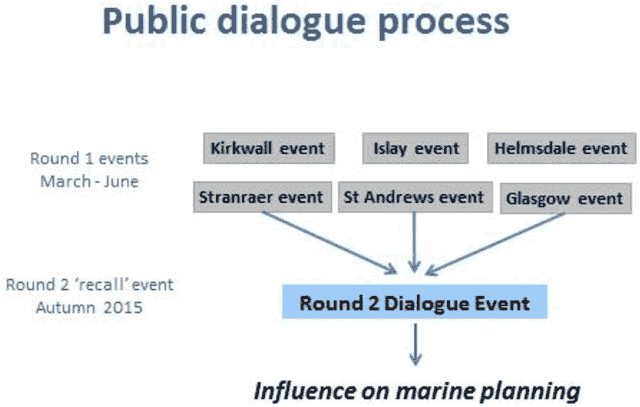
5.1 Objectives of the Round 1 dialogue
As dialogue is an iterative process which involves both conversations and time for reflection, the two rounds of the dialogue were designed to build up a picture of the things that mattered to participants and the ways in which the development of offshore renewables could potentially change these, either positively or negatively. Some of the project objectives shown in Table 5.1 are objectives for the whole dialogue process and not for Round 1 alone. Other objectives (shown in italics) relate to the way that the dialogues were carried out (‘process objectives’).
Table 5.1 Round 1 objectives, outputs and success criteria
Dialogue objectives
To design and run a dialogue process that:
- Enables individuals to participate freely without prejudice, where their input is listened to and respected.
- Enables participants to identify and explore the things (both physical things as well as relationships and activities) that are important in their lives.
- Gives participants the opportunity to examine realistic scenarios for the development of offshore renewables and consider how these might affect the things that they value.
- Collects information in a way that is transparent to members of the public and which can be analysed and interpreted to inform MS’ future decision making.
- Explores how members of the public would like MS, other decision-makers and developers to engage with them in the future, considering the most appropriate tools for engagement.
Dialogue outputs
A structured way of describing the types of things that are important to members of the public (social values) and the ways that these might be affected, positively or negatively, by offshore renewables.
A process for assessing social impacts that incorporates social values and the ways in which members of the public feel that these could be affected, positively or negatively, by offshore renewables.
Success criteria
Participants feel that they have been able to contribute their views and have their say and that the events will have an impact on policy (from Evaluation Questionnaires)
Participants recognise that their views have been reflected in the proposed approaches for assessing social impacts. Participants, policy-makers and scientists feel that the dialogue is a worthwhile and legitimate part of the policy-making process.
Dialogue objectives
To involve members of the general public who have not been previously engaged in marine development issues.
Dialogue outputs
Public participants reflect a range of perspectives and interests and are able to articulate and reflect on their differences and the points on which they agree.
Success criteria
The public participant and specialist perspectives are generally recognised to reflect a good cross-section of public and specialist viewpoints.
Dialogue objectives
To develop new approaches to understanding and assessing social impacts that are able to account for complex social interactions and heterogeneous communities, reflecting lived experience.
Dialogue outputs
Public participants’ descriptions of what is important to them in their lives and their reflections on how these important things might potentially be affected, either positively or negatively, by offshore renewables, are used to develop sets or categories of values and potential impacts that can be used in social impact assessment.
Success criteria
Public participants recognise the proposed descriptions and categories of social values and the potential positive and negative impacts on them as reflecting their own experience and what has been discussed during the dialogue.
Dialogue objectives
To understand the impact of development or change on things people value and factors that contribute to this impact.
Dialogue outputs
Reflections by public participants on how they think about valued and important features in their lives. Reflections by public participants on wider societal aspects such as social equity, future generations, etc.
Success criteria
Use of learning from the project in other parts of Marine Scotland and /the Scottish
Government
Dialogue objectives
To carry out the project in the knowledge of other research, ensuring it is informed by relevant research and builds on the current knowledge base.
Success criteria
Demonstrable academic rigour applied in the analysis of evidence and development of approaches.
5.2 Locations and participants
The dialogue locations were selected by the Steering Group. The dialogue events did not involve talking to participants about actual or potential developments but used scenarios to stimulate commentary around potential social impacts and how to assess these in a hypothetical community.
The rationale for selection provides some context for the workshops. In each location, the facilitation team found that participants provided additional information about the local context. This information is summarised in Table 5.2.
Table 5.2 Dialogue locations and contextual information
Dialogue location
Kirkwall (Pentland Firth and Orkney Waters)
Marine Scotland selection criteria
Initially hoped dialogue would contribute to pilot Marine Spatial Plan. Useful experience on shipping / fishing / oil and gas / incoming workers etc.
Contextual information provided by participants
Existence of community-owned and managed onshore wind energy installations at Shapinsay near Kirkwall as well as other locations.
Dialogue location
Port Ellen, Islay (Argyll and the islands)
Marine Scotland selection criteria
Areas identified by the Sectoral Plan. Interest in consultation for the sectoral plans.
Contextual information provided by participants
Renewable energy projects have been proposed in the past but have disappeared without the community being involved or provided with information.
Dialogue location
Helmsdale, Caithness
Marine Scotland selection criteria
Close to Beatrice Offshore Wind Farm development site.
Contextual information provided by participants
Two operational onshore wind farms in area have been strongly opposed by some local people.
Dialogue location
Stranraer (Dumfries and Galloway – Solway)
Marine Scotland selection criteria
A lot of interest and comment on Marine Scotland’s consultation for the sectoral plans.
Contextual information provided by participants
The ferry port at Stranraer closed in 2011 after 150 years in operation, leaving a void in the town.
Dialogue location
St Andrews, Fife
Marine Scotland selection criteria
Close to Forth and Tay wind farm sites.
Contextual information provided by participants
Current development in Guardbridge, outside the town, will generate energy from biomass for the University.
Dialogue location
Glasgow
Marine Scotland selection criteria
Central location (not coastal)
Contextual information provided by participants
Participants not from coastal communities; several brought ‘local’ knowledge from work or visits to coastal locations.
5.2.1 Recruitment of participants
A total of 96 people participated in the six dialogues. Each of the Round 1 dialogue events involved 13 to 18 public participants and up to 3 specialist participants from Marine Scotland. The public participants were recruited in the street by a recruitment company (Plus Four Market Research Ltd), to ensure that the groups reflected national demographics. The screening process considered the following criteria:
- Residence (all participants are living in the location);
- Involvement in consultations on offshore renewables (to screen out people who had participated previously representing organisations: in fact, no people representing organisations put themselves forward for recruitment);
- Gender (equal representation of men and women);
- Age (all participants over 16 and a good spread of ages);
- Ethnic background (reflective of the local area);
- Employment status (spread of types of employment); and
- Level of education (spread of levels of education).
The full screening document is included in Appendix 1 and the profile of participants for each session is in Appendix 2.
5.3 Round 1 dialogue process
Each dialogue events were held on a Saturday to enable the participation of as wide a range of people as possible. The programme ran from 10am – 4pm, allowing enough time for participants to engage with the process and to gain some information about offshore renewables.
The agenda for the day included a variety of different activities and is shown as Table 5.3. There is a description of the key activities in which public participants took an active role below. The full process plan for the Round 1 dialogues is included at Appendix 3.
Table 5.3 Agenda for the Round 1 Public Dialogue events
| Time | Activity |
|---|---|
| 10.00 | Welcome and Introductions |
| 10.25 | What’s important to you |
| 10.40 | Building your community – mapping values |
| 11.15 | BREAK |
| 11.35 | Introduction to offshore renewables (Marine Scotland) |
| 12.30 | Imagining futures with offshore renewable energies – what would it mean for you? Scenario 1: Generic changes (developments common to all offshore renewables) |
| 12.30 | LUNCH |
| 13.15 | Imagining futures with offshore renewable energies – what would it mean for you? Scenario 2: Wind energy 1 Scenario 3: Wind energy 2 |
| 14.20 | BREAK |
| 14.30 | Imagining futures with offshore renewable energy – what would it mean for you? Scenario 4: Tidal energy |
| 15.00 | Review of scenarios |
| 15.30 | Engaging with Marine Scotland |
| 15.45 | Conclusions and next steps |
| 16.00 | CLOSE |
The activities were designed and planned to ensure that their outputs would allow the objectives for this round of the dialogue to be met. The activities and their outputs are summarised below.
- Icebreaker postcards: On arrival, participants were given a postcard to write ‘to a friend’, telling them about a favourite place, why it was special and their aspirations for that place. This prompted conversations between participants and encouraged them to start thinking about places that were important to them (this was a recurring theme throughout the dialogue event);
Outputs: participants got into the mood for the dialogue; participants shared ideas; the texts written on the postcards provided additional information about people’s values.
- Dot posters: before the start of the dialogue event, participants were asked to give their opinions on three questions, each written on a separate poster and displayed on the wall, by putting a dot on a scathe scale below. The questions were: 1) How much do you know about renewable energy installations (wind, wave, tidal) in the sea? (Scale: everything – nothing at all); 2) To what extent do you think that offshore renewable energies will affect your life? (Scale: not at all – change completely); and 3) How positivenegative do you think that the development of offshore renewable energies will be for you? (Scale: very positive – very negative).
The participants answered the same three questions at the end of the day, using a different coloured dot.
Outputs: this activity provided information about changes in participants’ views as a result of the dialogue event. The responses at the start of the day were compared with the responses at the end of the day, to see how far people’s positions had moved. The completed dot posters are reproduced and discussed in Chapter 7.
- Concentric circles diagrams: each participant was given a piece of A3 paper with faint concentric circles and a figure in the middle. They were asked to write or draw the things that were most important for them on the concentric circles: participants were told to place the things that were more important to them closer to the figure.
Outputs: a set of concentric circle diagrams that enabled people to identify things they valued. The output was a reflection by public participants on how they thought about valued and important features of their lives.
- Putting things of value on a map: participants chose icons (in the form of paper markers or flags) to represent each of the things they had shown on their concentric circles diagrams and then, with the other members of their groups, placed these markers on a map of an imaginary coastal settlement. The group discussed what was in this place they had created.
Outputs: a map which was used during the following sessions to explore the impacts of offshore renewables. As each group produced its own map, the groups were able to compare their work, and it was possible to make comparisons across dialogue locations.
- Exploration of realistic future scenarios involving the development of offshore renewables: participants use the map of a coastal location with the icons of things of value that they have placed on it, along with short summaries of a credible future scenarios for the development of offshore renewables, as the basis for a discussion of how different kinds of development of offshore renewables might impact on the things they value.
Outputs: recorded conversations for each of the groups about the things that members of the group valued that might be affected, positively or negatively by the development of offshore renewables.
- Dialogue between public participants and specialists on offshore renewables and their potential impacts, both positive and negative: specialists with different areas of expertise (e.g. offshore renewables, social impacts etc.) joined the group discussions in order to provide information when requested and to engage in dialogue with members of the public.
Outputs: increased understanding by specialists of public values and how these are reflected in their interests and concerns about offshore renewables and, on the part of the public, a fuller understanding of offshore renewables technologies and the approaches used to assess their impacts on individuals and local communities.
5.4 Round 1 dialogue materials
The use of materials which enable participants to engage directly with the subject matter is a key element of the dialogue approach. Specialists participated in all the sessions which covered technical information (all except the discussion of personal values), which meant that they could respond to participants’ technical questions from their own perspective: this generated two-way conversations in which both public participants and specialists developed their understanding of the views and priorities of others.
Public participants first created their own individual pictures of the valued and important features of their lives using a diagram with a figure in the middle of three concentric circles, as shown at Figure 5.2, with an example of a completed picture shown at Figure 5.3.
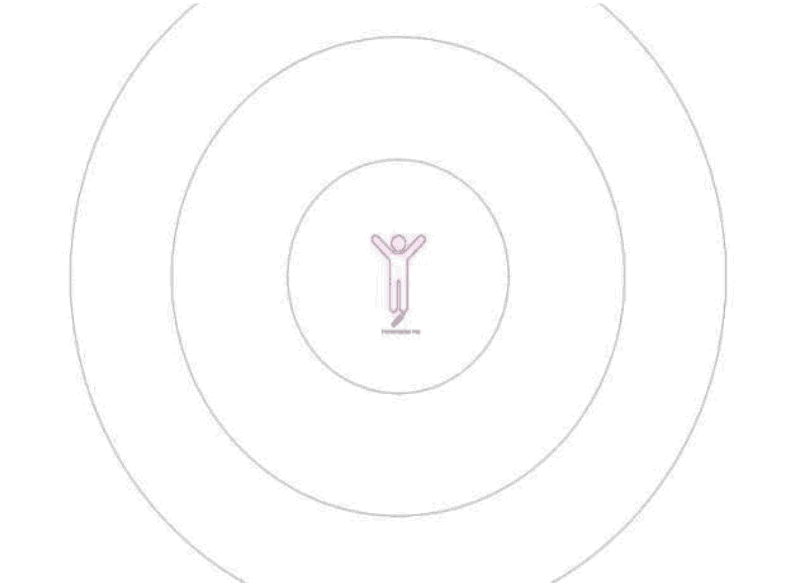
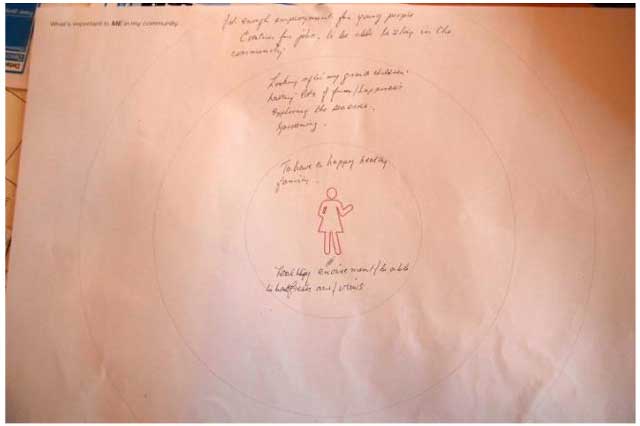
They then converted the features identified into elements on a shared map of a hypothetical coastal location (see Figure 5.4) which became the site for the scenarios for the development of different offshore renewable energy technologies. Figure 5.4 shows participants using a map to discuss offshore renewables scenarios.
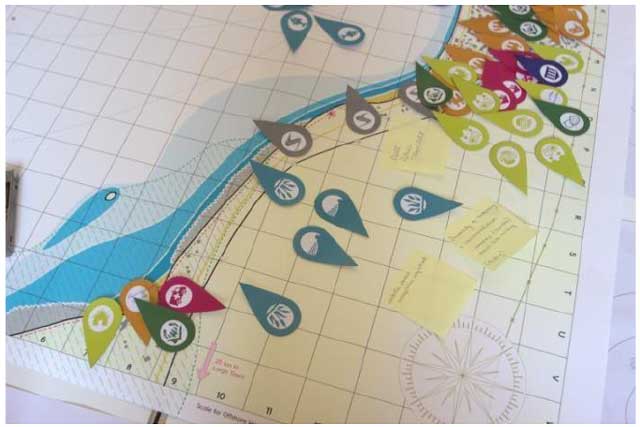
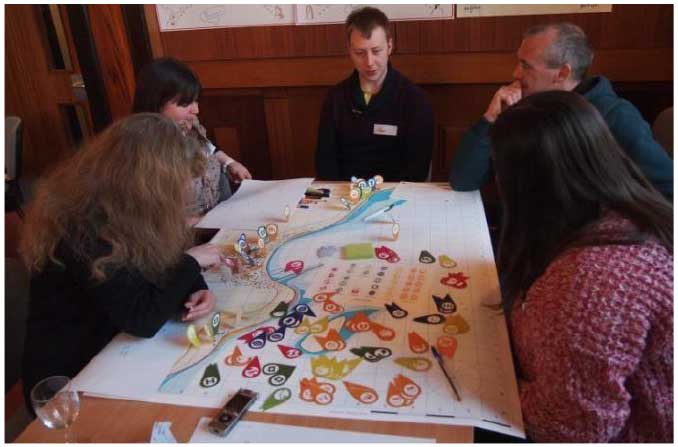
In Round 2, the social values and the potential impacts on them of offshore renewables developments that had been identified during Round 1 were presented on a map of Scotland, to facilitate comparison between locations. Other materials were also designed to be a focus for discussion between public participants and between participants and specialists:
- A diagram of the SIA process with icons to enable participants to add opportunities engagement; and
- Examples of materials for engagement techniques.
A description of the materials used in Round 2 is given in Chapter 8. Further details about all the dialogue materials are provided in Appendix 4.
Contact
There is a problem
Thanks for your feedback